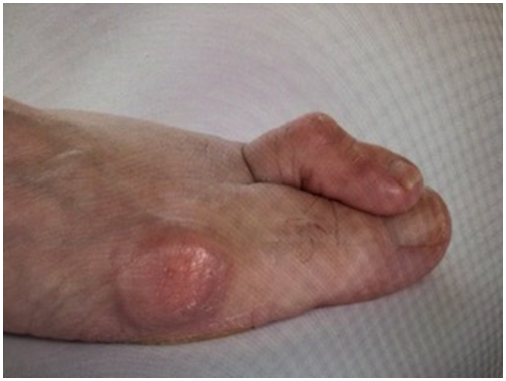Information
Several toe deformities of the toes can develop and it is very common that with age some of the toes become bent. The deformities can appear at any of the toe joints and are given different names.
A hammer toe is a deformity of the “knuckle” of the second, third or fourth toes causing it to bend. The knuckle often rubs on footwear and becomes uncomfortable. Sometimes this can cause abrasion to the skin and the formation of corns or even breakdown of the skin (ulcer). Occasionally the ulcer becomes infected and may need treatment with antibiotics
A mallet toe is a similar condition affecting the end joint of the toe. Sometimes the end of the toe or even the toe nail can come into contact with the ground and cause a painful corn or ulcer.
A claw toe is a combination of both of the above deformities and can cause problems over the knuckle of the toe and at the tip of the toe.
What causes a hammer toe?
A hammer toe often occurs secondary to hallux valgus and therefore sometimes it is not possible to deal with the second toe in isolation and the big toe has to be straightened at the same time to allow correction of the 2nd toe into the gap.
Less common is an injury of a ligament under the toe (plantar plate tear) which often painful at the metatarso-phalangeal joint often with minimal or no deformity.

Changing footwear to extra width or special footwear possibly with a cushion-pad or in-shoe foot support. Avoid high heels and shoes with a narrow toe.
Pads: symptomatic relief, such as silicone toe pads (available over-the-counter at the pharmacy or online) to stop footwear rubbing. Insoles and toe spacers can also help, although they will not straighten out the toe or take away the bump.
Podiatry: a podiatrist can help with hammer toe symptoms and issue pads/insoles/orthoses which can improve foot posture and pain in the joint. You can self refer to a NHS podiatrist or seek care privately.
Surgical treatment
Hammer toe/mallet toe correction surgery is commonly performed and will help relieve pain and improve the alignment of the toe in most people. There is no guarantee that the toe will be perfectly straight or pain-free after surgery but about 80% will have a good outcome from toe straightening surgery.
Indications for surgery
Surgery may be needed if the above measures have been tried and failed. Some patients worry that the deformity may become worse and therefore prefer it to be corrected earlier rather than later. However, rapid progression of a hammer toe/mallet toe deformity is unusual. The decision to go ahead with surgery is usually made based on the following symptoms:
- The deformity is painful and worsening
- Difficulty obtaining suitable shoes
- The overlying skin has broken down (ulcerated) or become infected
- There is significant disruption to lifestyle or activities
M.A. & J. McK. 11-09-24
Who can refer:
GPs
Who to refer:
- Patients with painful lesser toe deformities
- Patients with skin ulcerations over lesser toe joints
- Patients who has limited mobility due to deformity,
Who not to refer:
- Cosmetic reasons
- Peripheral arterial disease
Minimal referral details:
Patient has been seen by podiatry
Length of time since symptoms started
Non-surgical treatments
Changing footwear to extra width or special footwear possibly with a cushion-pad or in-shoe foot support. Avoid high heels and shoes with a narrow toe.
Pads: symptomatic relief, such as silicone toe pads (available over-the-counter at the pharmacy or online) to stop footwear rubbing. Insoles and toe spacers can also help, although they will not straighten out the toe or take away the bump.
Podiatry: a podiatrist can help with hammer toe symptoms and issue pads/insoles/orthoses which can improve foot posture and pain in the joint. You can self refer to a NHS podiatrist or seek care privately.
Straightening Surgery of Hammer/Mallet toe: https://edinburghorthopaedics.org/media/gzeavt3v/toe-straightening-surgery-guide-v2-0.pdf













